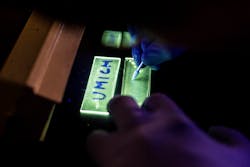Ordinary fluorescent organic LEDs (OLEDs) can achieve a maximum light-emitting efficiency of only 25%; this is because, while the decay of singlet excitons to create light in the flourescence process is quantum-mechanically permitted, the decay of triplet excitons (which would produced the missing 75% efficiency) is forbidden. In contrast, phosphorescent OLEDs generate light from both triplet and singlet excitons, resulting in a theoretical efficiency of 100%.
So why aren't all OLEDs phosphorescent? It is because today's organic technologies rely on metals in the organic semiconductor to enable phosphorescence, which is expensive and sometimes toxic.
Now, Jinsang Kim, a professor of materials science and engineering at the University of Michigan (Ann Arbor), and his team have developed bright, metal-free phosphorescent OLEDs.1
They had done this previously by stiffening the organic crystals, stifling energy-wasting vibrations and allowing more energy to be released as light. The group's crystals produced light from 55% of the charges; however, it is very difficult to consistently produce these high-quality crystals in manufacturing.
So as an alternative, the group sought to provide such rigidity with less effort by tweaking the design of the phosphor molecules to form structural halogen and hydrogen bonds with a transparent polymer (polyvinyl alcohol). They heated and dried a solution containing the newly devised light emitters and polymers, and the molecules self-assembled into a stiff matrix. This design allowed 24% of the charges to produce light. While this number is only about as good as that from fluorescent OLEDs, the team is working on a complementary way to further improve the efficiency.
Also changes color when exposed to water
The material can also reveal the presence of water. By dissolving the connections between the polymers, water breaks the bonds that allow the charges that could produce fluorescence to convert to phosphorescent states. Those bonds cause the light emitter to give off mostly phosphorescent light (green for this material), but when the bonds break, it switches to the fluorescent mode (blue for this material).
This could lead to simple sensors for detecting water. For example, dentists need a way to check that a cavity is totally dry before filling it to ensure a secure bond and minimize inflammation; a probe made with this material would change from green to blue on exposure to a small amount of water.
Source: http://ns.umich.edu/new/releases/22291-toward-ultimate-light-efficiency-on-the-cheap
REFERENCE:
1. Min Sang Kwon et al., Angewandte Chemie (2014); DOI: 10.1002/anie.201404490

John Wallace | Senior Technical Editor (1998-2022)
John Wallace was with Laser Focus World for nearly 25 years, retiring in late June 2022. He obtained a bachelor's degree in mechanical engineering and physics at Rutgers University and a master's in optical engineering at the University of Rochester. Before becoming an editor, John worked as an engineer at RCA, Exxon, Eastman Kodak, and GCA Corporation.
